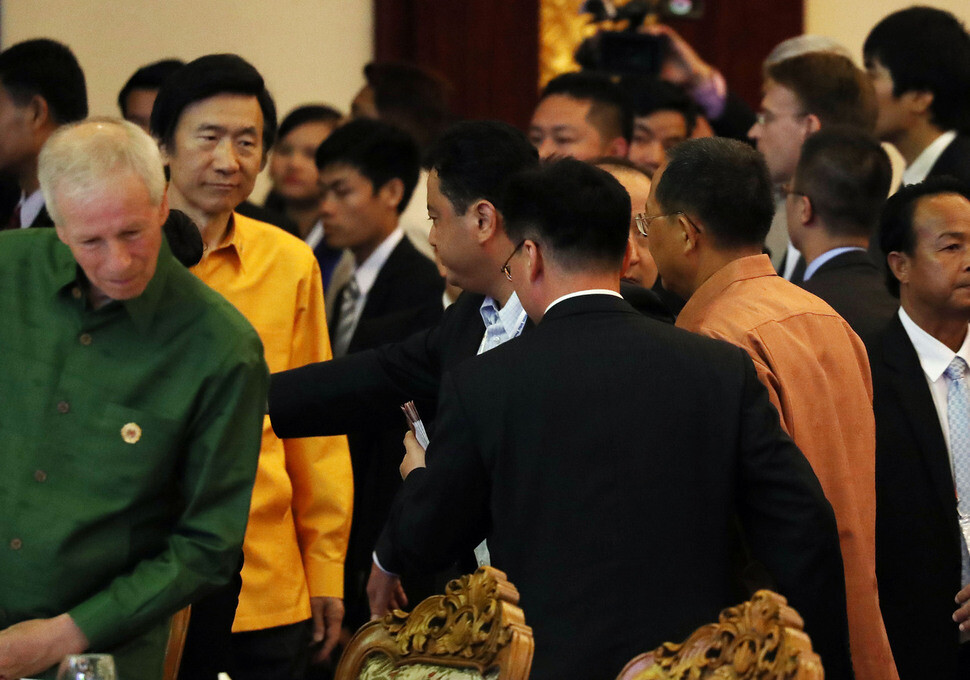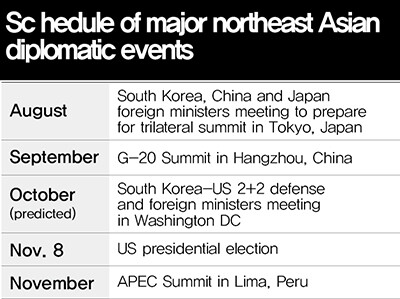hankyoreh
Links to other country sites 다른 나라 사이트 링크
[Analysis] Diplomatic battles at the ASEAN Regional Forum

The ASEAN Regional Forum that took place in Vientiane, capital of Laos, from July 24 to July 26 and the meetings of foreign ministers from ASEAN (the Association of Southeast Asian Nations) made clear the diplomatic reality confronting the key players in Northeast Asia - including North Korea, South Korea, the US and China - and showed which countries are close to each other and which are not. Add in Japan and Russia, and you have a complete picture of all the countries involved in the Six-Party Talks.
Since the forum took place amid the South China Sea dispute, the North Korean nuclear issue and the controversial decision to deploy the THAAD missile defense system with US Forces Korea, it has been described as a litmus test for affairs in Northeast Asia.
This article is a recap of the diplomatic battle fought at Vientiane by the various Northeast Asia countries.

The forum provided tentative confirmation that the controversy about the THAAD deployment could be a catastrophe for South Korean foreign policy. The fact that Chinese Foreign Minister Wang Yi gave South Korea the cold shoulder and North Korea a warm welcome suggests that choppy seas are ahead for South Korean diplomats.
The domestic and international media are more interested in the THAAD controversy than in dealing with the North Korean nuclear issue, which can be seen as a leading indicator of this. Even though a consensus has already formed in the international community about sanctions against North Korea following Pyongyang’s fourth nuclear test in January, South Korean Foreign Minister Yun Byung-se is anxious that the reference to the North Korean nuclear program in the forum’s statement will be weaker than in previous years.
The most troubling factor for the challenges that are in store for South Korean diplomats is the fact that, if the Chinese government remains opposed to the THAAD deployment and takes countermeasures, there is little South Korea can do about it.
North Korea: exploiting international friction to break out of its own isolation
North Korean Foreign Minister Ri Yong-ho was at ease during the forum. This attitude was not what you might expect from the top diplomat of North Korea, which was forced into even greater international isolation by UN Security Council No. 2270.
Ri‘s contentment reflects the fact that regional affairs are playing out just as North Korea had hoped they would. The battle lines are gradually becoming clearer between the US and Japan on the one hand and China on the other in the South China Sea dispute and between South Korea, the US and Japan on the one hand and North Korea, China and Russia on the other in regard to the THAAD controversy.
As those battle lines are drawn, it is inevitable that cracks will form in international cooperation on sanctions against North Korea, and it is possible that North Korean diplomats will have more room to work.
During the ASEAN Regional Forum last year, North Korea and China did not hold a foreign ministers meeting, and their relations became even more strained after North Korea’s fourth nuclear test. But in this year’s forum there were signs that their relations have started to thaw.
As if in response to China’s friendly welcome, Ri expressed definite support for China in the South China Sea dispute. “The US is further complicating regional affairs by meddling in the maritime dispute in the Asia-Pacific region,” he said.
China: squirming like a dragon in a trapThe person who received the most attention during the forum was Wang. But Wang did not exhibit the ease of the attacker but the desperation of the defender. The dragon of China had been caught in a trap set by the US, and it writhed in an attempt to escape. China was forced to defend itself from two American attacks at once: the South China Sea dispute through the US proxy of the Philippines, and the THAAD deployment through the US proxy of South Korea. Through THAAD, the US hopes to forward deploy a missile defense network in Northeast Asia.
Chinese diplomats find themselves in a complicated and challenging predicament. Even as Wang put on a “diplomatic protest” by treating South Korea coolly and North Korea warmly, he reiterated China’s three principles for denuclearization of the Korean Peninsula in response to North Korea’s threats to strengthen its nuclear deterrent.
Wang had to put pressure on South Korea to retract its decision to deploy THAAD while also preventing the unwelcome possibility of South Korea becoming a junior partner in the US-Japan alliance.
While Wang’s bilateral meeting with Japanese Foreign Minister Fumio Kishida resulted in a sharp quarrel over the South China Sea that was reminiscent of a neighborhood shouting match, Wang accepted Japan’s proposal to hold a trilateral meeting of the foreign ministers of South Korea, China and Japan in August to discuss the question of holding a trilateral summit.
Even more importantly, China needs the cooperation of South Korea, the US and Japan in order to successfully host the G-20 Hangzhou Summit this September, which is supposed to give Chinese President Xi Jinping a chance to show off his diplomatic leadership. This is why Wang‘s behavior during the forum looked a little schizophrenic.
The US: a dangerous aggressorIf Wang was the desperate defender, US Secretary of State John Kerry was the relaxed attacker. On all three of the pressing issues - the South China Sea, the North Korean nuclear issue and THAAD - the US is on the offense and China is on defense.
During Kerry’s bilateral meeting with Yun, the two leaders agreed to hold a “two plus two” minister meeting (between the top defense and foreign policy officials) this year in order to discuss ways the two countries can cooperate to globalize the US-ROK alliance.
On July 27, Kerry met with Rodrigo Duterte, president of the Philippines, to work out a plan for dealing with the South China Sea dispute following the July 12 ruling by the Permanent Court of Arbitration. The Philippines was the country that brought a lawsuit against China on the issue of the South China Sea, and China was the target of these actions.
During the official welcome dinner at the meeting of foreign ministers at the ASEAN Regional Forum on July 25, Kerry warmly greeted the foreign ministers of Pakistan and Papua New Guinea, who were sitting on both sides of Ri Yong-ho, but he did not even glance at Ri. This diplomatic gesture was calculated to show that the US does not care about North Korea.
By Lee Je-hun, staff reporter in Vientiane
Please direct questions or comments to [english@hani.co.kr]

Editorial・opinion
![[Column] Park Geun-hye déjà vu in Yoon Suk-yeol [Column] Park Geun-hye déjà vu in Yoon Suk-yeol](https://flexible.img.hani.co.kr/flexible/normal/500/300/imgdb/original/2024/0424/651713945113788.jpg) [Column] Park Geun-hye déjà vu in Yoon Suk-yeol
[Column] Park Geun-hye déjà vu in Yoon Suk-yeol![[Editorial] New weight of N. Korea’s nuclear threats makes dialogue all the more urgent [Editorial] New weight of N. Korea’s nuclear threats makes dialogue all the more urgent](https://flexible.img.hani.co.kr/flexible/normal/500/300/imgdb/original/2024/0424/7317139454662664.jpg) [Editorial] New weight of N. Korea’s nuclear threats makes dialogue all the more urgent
[Editorial] New weight of N. Korea’s nuclear threats makes dialogue all the more urgent- [Guest essay] The real reason Korea’s new right wants to dub Rhee a founding father
- [Column] ‘Choson’: Is it time we start referring to N. Korea in its own terms?
- [Editorial] Japan’s rewriting of history with Korea has gone too far
- [Column] The president’s questionable capacity for dialogue
- [Column] Are chaebol firms just pizza pies for families to divvy up as they please?
- [Column] Has Korea, too, crossed the Rubicon on China?
- [Correspondent’s column] In Japan’s alliance with US, echoes of its past alliances with UK
- [Editorial] Does Yoon think the Korean public is wrong?
Most viewed articles
- 1‘We must say no’: Seoul defense chief on Korean, USFK involvement in hypothetical Taiwan crisis
- 2N. Korean delegation’s trip to Iran shows how Pyongyang is leveraging ties with Moscow
- 346% of cases of violence against women in Korea perpetrated by intimate partner, study finds
- 4[Column] Park Geun-hye déjà vu in Yoon Suk-yeol
- 5‘Weddingflation’ breaks the bank for Korean couples-to-be
- 6Will NewJeans end up collateral damage in internal feud at K-pop juggernaut Hybe?
- 7Amnesty notes ‘erosion’ of freedom of expression in Korea in annual human rights report
- 8[Interview] Dear Korean men, It’s OK to admit you’re not always strong
- 9Korean government’s compromise plan for medical reform swiftly rejected by doctors
- 10[Editorial] Japan’s rewriting of history with Korea has gone too far